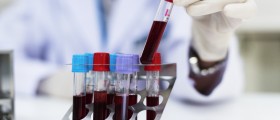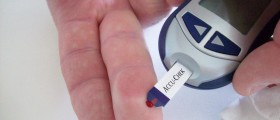
Blood is the only liquid tissue in our organism. It reaches everywhere, it supplies all cells in our bodies with what they need, takes away their waste, and serves as a messenger. In example, hormones secreted in one organ tell some faraway organ what to do, and it is up to blood to carry the hormones over. It carries mobile defence units.
Therefore, a blood test is a good way to see what's going on inside our bodies. There are many things in blood which can be above, below or within their normal levels, and knowing how to interpret results helps us to determine if everything is OK or something less than desirable is going on. There are a few parameters that can be interpreted flawlessly by anybody. In example, it is easy to see if your blood sugar level is too high, but thorough interpretation of results (in example, relation between count of various types of white blood cells), specifically if you are being tested for some disorder or disease, is a job for professionals.
Form
A typical blood test result will have name of the parameter (typically, it is a type of blood cell, hormone, mineral, metabolic product or by-product or whatever you were tested for), numerical value indicating its quantity in standard measurement unit (decilitre, litre, cubic millimetre or whatever the conventional measure is), and two numbers that stand for upper and lower limit of normal range.
Common knowledge
Haemoglobin is substance in red blood cells that transports oxygen and carbon dioxide. Normal range for adults is between 13 and 15.5 grams/decilitre (one tenth of a litre).
Red blood cells are packed with haemoglobin and can be regarded as true oxygen/carbon dioxide transportation units. Normal range for male adults is 4.7 to 6.1 million cells per cubic mm and 4.2 to 5.4 million cells per cubic mm for female adults.
Hematocrite value shows how much volume of blood are red blood cells. Normal range is 38.5 to 49.0%.
Mean Corpuscular Volume or MCV shows how large your red blood cells are. Normal range is 80 to 97, and values lower than this can indicate anemia or some other blood condition.
These results are almost self-explanatory and easy to interpret. It becomes complicated when hormones are involved, and we commoners can do little but see whether parameters are within normal range or not. How’s and why’s of these results are for doctors to interpret.
Thyroid test shows levels of TSH hormone and T3 and T4 hormones, secreted under influence of TSH. Normal TSH range for adults is from 0.4 to 4.5 mil. units per litre, and from 3 to 18 for infants. Normal T3 levels for adults are from 0.2 to 0.5 nanograms per decilitre, and for T4 from 0.75 to 1.45 nanograms per decilitre. Normal T4 range in infants is from 0.9 to 2.2 nanograms per decilitre.
Lipid panel test shows levels of various types of fat. LDL cholesterol is the "bad fat" and its levels should be under 100 mg per dL (decilitre) in a healthy adult. HDL cholesterol is the 'good fat' and more is better. Lower limits are 40 mg per dL for adult men and 50 mg/dL for adult women. If you are below this, consult with your doctor to see what can be done to improve its status. Triglycerides should be below 150 mg per dL.












-During-Pregnancy_f_280x120.jpg)



Your thoughts on this
Loading...